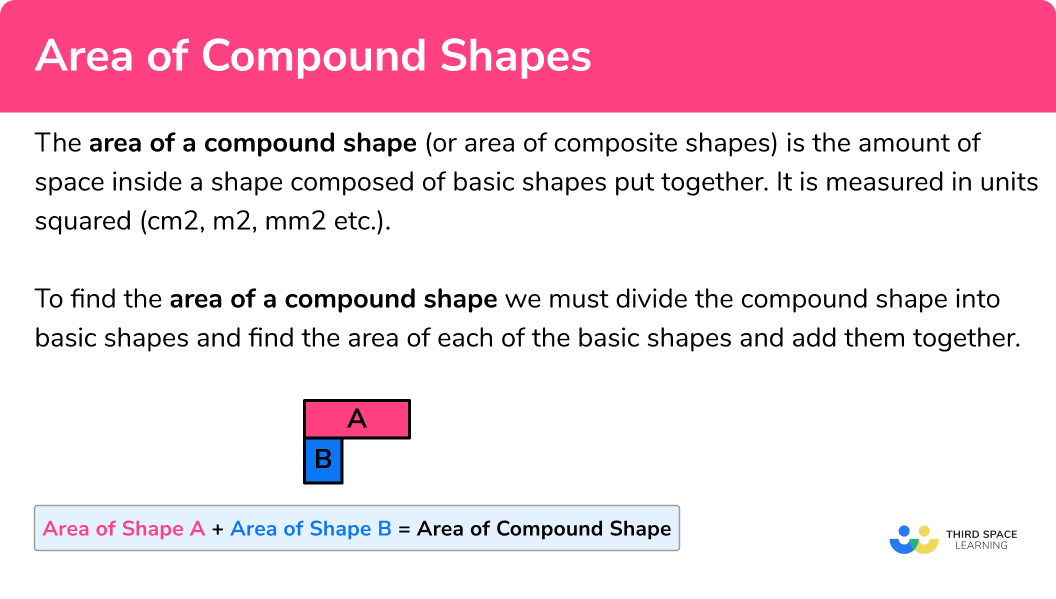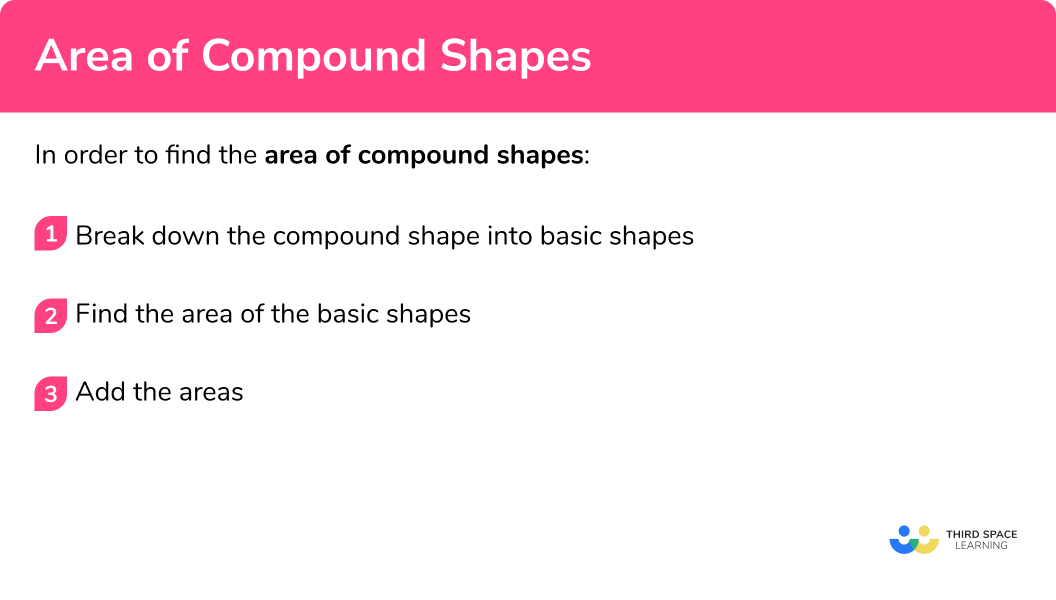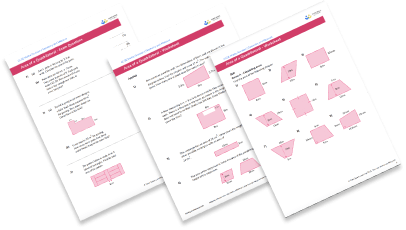GCSE Tutoring Programme
Our chosen students improved 1.19 of a grade on average - 0.45 more than those who didn't have the tutoring.
This topic is relevant for:

Area Of Compound Shapes
Here we will learn about the area of compound shapes, including questions involving rectilinear shapes, composite shapes, missing side lengths and unit conversion.
There are also area of compound shape worksheets based on Edexcel, AQA and OCR exam questions, along with further guidance on where to go next if you’re still stuck.
What is the area of compound shapes?
The area of compound shapes (also known as the area of composite shapes) is the amount of space inside a shape composed of basic shapes put together. It is measured in units squared ( cm^2 , m^2, mm^2 etc.).
Compound shapes can also be called composite shapes.
To find the area of compound shapes we must divide the compound shape into basic shapes and find the area of each of the basic shapes and add them together.
Our final answer must be in square units e.g. square centimetres (cm^2) , square meters (m^2) , square feet (ft^2), etc.
What is the area of compound shapes?

How to find the area of compound shapes
In order to find the area of compound shapes:
- Break down the compound shape into basic shapes.
- Find the area of the basic shapes.
- Add the areas.
Explain how to find the area of compound shapes


Area of compound shapes worksheet

Get your free area of compound shapes worksheet of 20+ questions and answers. Includes reasoning and applied questions.
DOWNLOAD FREE
Area of compound shapes worksheet

Get your free area of compound shapes worksheet of 20+ questions and answers. Includes reasoning and applied questions.
DOWNLOAD FREERelated lessons on area
Area of compound shapes is part of our series of lessons to support revision on area. You may find it helpful to start with the main area lesson for a summary of what to expect, or use the step by step guides below for further detail on individual topics. Other lessons in this series include:
- Area
- Area of a circle
- Area of a triangle
- Area of a trapezium
- Area of a parallelogram
- Area of a rectangle
- Pi r squared
- Area of a rhombus
- Area of an isosceles triangle
- Area of an equilateral triangle
- Area of a right angled triangle
- How to work out area
- Area of a quadrilateral
- Area of a hexagon
- Area of a pentagon
Area of compound shapes examples
Example 1: all side lengths given (area of the L shape)
Find the area of the compound shape below:
- Break down the compound shape into basic shapes.
Split the compound shape into two rectangles. We can do this in two ways:
For the purposes of this question we will use the first way.
2Find the area of the basic shapes.
Let us label the two rectangles A and B :
Area of Rectangle A :
\begin{aligned} \text { Area }_{A} &=\text { length } \times \text { width } \\\\ \text { Area }_{A} &=6 \times 5 \\\\ &=30 \end{aligned}
Area of Rectangle B :
\begin{aligned} \text { Area }_{B} &=\text { length } \times \text { width } \\\\ \text { Area }_{B} &=9 \times 4 \\\\ &=36 \end{aligned}
3Add the areas.
\begin{aligned} \text { Compound Area } &=\text { Area of } A+\text { Area of } B \\\\ &= 30+36 \\\\ &=66 \end{aligned}
4Write down your final answer with units squared.
\text { Area }=66 \mathrm{~m}^{2}
Example 2: missing lengths
Find the area of the compound shape below:
Break down the compound shape into basic shapes.
Split the compound shape into two rectangles and find the area of each rectangle:
Find the area of the basic shapes.
Let us label the two rectangles A and B .
Area of Rectangle A :
We need to calculate the unknown length. To do this we need to use the measurements we are given in the question that are parallel to the unknown side:
If we add together the 3 sides, we will get the length of rectangle A .
4+5+5= 14m
\begin{aligned} \text { Area }_{A} &=\text { length } \times \text { width } \\\\ \text { Area }_{A} &=14 \times 2 \\\\ &=28 \end{aligned}
Area of Rectangle B :
We need to calculate the unknown length. To do this we need to use the measurements we are given in the question that are parallel to the unknown side:
The length of the entire compound shape is 10m . We need to subtract the 2m of shape A to get just the length of shape B .
10-2=8
\begin{aligned}
\text { Area }_{B} &=\text { length } \times \text { width } \\\\
\text { Area }_{B} &=8 \times 5 \\\\
&=40
\end{aligned}
Add the areas.
\begin{aligned} \text { Compound Area } &=\text { Area of } A+\text { Area of } B \\\\ &=28+40 \\\\ &=68 \end{aligned}
Write down your final answer with units squared.
\text { Area }=68 \mathrm{~m}^{2}
Example 3: worded question
The wall shown below needs to be painted. Each tin of paint covers a distance of 4 square metres. How many tins of paint will be needed to cover the entire wall?
Break down the compound shape into basic shapes.
Split the compound shape into three rectangles:
Find the area of the basic shapes.
Let us label the two rectangles A, B and C .
Area of Rectangle A :
\begin{aligned}
\text { Area }_{A} &=\text { length } \times \text { width } \\\\
\text { Area }_{A} &=12 \times 5 \\\\
&=60
\end{aligned}
Rectangle C is congruent to Rectangle A so we can just double the area of rectangle A .
60 \times 2 = 120
Area of Rectangle B :
We need to calculate the unknown width. To do this we need to use the measurements we are given in the question that are parallel to the unknown side:
The entire width of the shape is 13m . If we subtract 5m and 5m (the width of rectangles A and C ).
13-5-5=3m
\begin{aligned} \text { Area }_{B} &=\text { length } \times \text { width } \\\\ \text { Area }_{B} &=7 \times 3 \\\\ &=21 \end{aligned}
Add the areas.
\begin{aligned} \text { Compound Area} &=\text { Area of } A+\text { Area of } B+\text { Area of } C \\\\ &=60+21+60 \\\\ &=141 \end{aligned}
Write down your final answer with units squared.
\text { Area }=141 \mathrm{~m}^{2}
While this is the total area we need to calculate how many tins of paint will be needed to cover the wall. If each tin of paint covers a distance of 4 square metres, we need to divide 4 into 141 .
141 \div 4=35.25
Since you cannot buy 0.25 of a can of paint, we need to round our answer to 36 tins of paint.
Answer = 36 tins of paint will be needed
Example 4: compound shapes involving non-rectangular shapes
Find the area of the compound shape below:
Break down the compound shape into basic shapes.
Split the compound shape into a triangle and rectangle:
*Note: This shape is a trapezium. Another way to find the area of this shape would be simply to use the formula for the area of a trapezium. For this question, because we are focusing on compound shapes, we will separate the shape into a triangle and a rectangle.
Find the area of the basic shapes.
Let us label the two shapes A and B .
Area of Triangle A :
\begin{aligned} \text { Area }_{A} &=\frac{b \times h}{2} \\\\ \text { Area }_{A} &=\frac{2 \times 8}{2} \\\\ &=8 \end{aligned}
Area of Rectangle B :
We need to calculate the unknown length. To do this we need to use the measurements we are given in the question that are parallel to the unknown side:
The height of the entire compound shape is 6m . We need to subtract the 2m of shape A to get just the length of shape B .
6-2=4
\begin{aligned}
\text { Area }_{B} &=\text { length } \times \text { width } \\\\
\text { Area }_{B} &=8 \times 4 \\\\
&=32
\end{aligned}
Add the areas.
\begin{aligned} \text { Compound Area } &=\text { Area of } A+\text { Area of } B \\\\ &=8+32 \\\\ &=40 \end{aligned}
Write down your final answer with units squared.
\text { Area }=40 \mathrm{~m}^{2}
Example 5: missing side lengths
Calculate the value of x in the compound shape below:
Break down the compound shape into basic shapes.
Split the compound shape into two rectangles.
Find the area of the basic shapes.
Let us label the two rectangles A and B .
Area of Rectangle A:
\begin{aligned} \text { Area }_{A} &=\text { length } \times \text { width } \\\\ \text { Area }_{A} &=8 \times 2 \\\\ &=16 \end{aligned}
In this case we are not given enough information to find the area of Rectangle B. .
Add the areas.
\begin{aligned} \text { Compound Area } &=\text { Area of } A+\text { Area of } B \\\\ 48 &=16+\text { Area of } B \\\\ \text { Area of } B &=48-16 \\\\ \text { Area of } B &=32 \end{aligned}
Now that we know the area of rectangle B, we can calculate the value of x .
\begin{aligned} \text { Area of } B &=l \times w \\\\ 32 &=l \times 4 \\\\ l &=\frac{32}{4} \\\\ l &=8 m \end{aligned}
x = 8m
Example 6: worded question
Below is a blueprint for a garden to be created in the middle of town. It will feature a triangular flowerbed and the remainder of the garden will be covered in grass.
Each roll of grass costs £24 and covers a distance of 3 square metres. How much will it cost to cover the garden with grass?
Break down the compound shape into basic shapes.
Split the compound shape into a rectangle and trapezium. Once we find the area of the two shapes we can subtract the area of the triangle.
Find the area of the basic shapes.
Let us label the three shapes A , B and C .
Area of Trapezium A :
Add the parallel sides: 10+11=21
Divide by 2: 21 \div 2=10.5
Times by the height: 10.5 \times 2=21m^2
Step by step guide: Area of a trapezium (Coming soon)
Area of Rectangle B :
\begin{aligned}
\text { Area }_{B} &=\text { length } \times \text { width } \\\\
\text { Area }_{B} &=11 \times 7 \\\\
&=77 \mathrm{~m}^{2}
\end{aligned}
Area of Triangle C :
We need to calculate the unknown width. To do this we need to use the measurements we are given in the question that are parallel to the unknown side:
The width of the entire compound shape is 11m . We need to subtract the 5m and 4m from 11m to get the width of shape C .
11-5-4=2
\begin{aligned}
\text { Area }_{C} &=\frac{1}{2}(\text { base } \times \text { height }) \\\\
\text { Area }_{C} &=\frac{2 \times 6}{2} \\\\
&=6 m^{2}
\end{aligned}
Add the areas.
\begin{aligned} \text { Compound Area } &=\text { Area of } A+\text { Area of } B-\text { Area of } C \\\\ &=21+77-6 \\\\ &=92 \end{aligned}
Write down your final answer with units squared.
\text { Area }=92 \mathrm{~m}^{2}
Common misconceptions
- Using incorrect units for the answer
A common error is to forget to include squared units when asked to calculate area.
Forgetting to convert measures to a common unit
Before using the formula for calculating the area of a rectangle, pupils must look at the units given in the question. If different units are given e.g. length = 4m and width = 3cm pupils must convert them either both to cm or both to m.
- Composite shapes
A composite shapes is the same as a compound shape
Practice area of compound shapes questions
1. Find the area of the compound shape below:
80m^2

65m^2

50m^2

80m

Split into two rectangles:
Area of A : 10 \times 5=50
Area of B : 4 \times 4=16
Compound Area: 50+16=66m^2
2. Find the area of the compound shape below:
50m^2

25m^2

104m^2

110m^2

Split into two rectangles:
Area of A : 10 \times 5=50
Area of B : 9 \times 6=54
Compound Area: 50+16=104m^2
3. The wall shown below needs to be painted. Each tin of paint covers a distance of 4 square metres. How many tins of paint will be needed to cover the entire wall?
42

166

41

150

Split into three rectangles:
Area of A : 15 \times 5=75
Area of B : 8 \times 2=16
Area of C : 15 \times 5=75
Compound Area: 75+16+75=166m^2
Then divide by 4 to get the number of tins.
4. Find the area of the compound shape below:
95,000cm^2

64,600cm^2

710cm^2

79,800cm^2

Split into one rectangle and two triangles:
Area of A : \frac{1}{2}(190\times80)=7600
Area of B : \frac{1}{2}(190\times80)=7600
Area of C : 170 \times 380=64600
Compound Area: 7600+7600+646000=79,800m^2
5. Calculate the value of x in the compound shape below:
4mm

7mm

77mm^2

22mm

Split into two rectangles:
Area of B : 4\times 11=44
\begin{aligned}
&56-44=12\\
&12\div3=4\\
&11-4=7mm
\end{aligned}
6. An architect is developing a blueprint for one floor of a house which is shown below. The shaded region represents the floor and will need to be fully tiled. Each square tile has a width of 12cm . How many tiles will be needed to cover the entire floor?
71

77

4931

6

Area of A : 7 \times 11=77
Area of B : \frac{1}{2}(4\times3)=6
\begin{aligned}
&77-6=71m^2 \\
&12cm = 0.12m
\end{aligned}
Area of 1 tile: = 0.12 \times 0.12=0.0144m^2
\begin{aligned}
&71\div0.0144=4930.56\\
\end{aligned}
4931 tiles
Area of compound shapes GCSE questions
1. The diagram below shows a shape. Work out the area of the shape.
(3 marks)
6 \times 7=42 seen
(1)
15\times5=75 seen or 5m seen as the missing vertical length
(1)
117m^2 (cao including units)
(1)
2. (a) A farmer owns the cattle field shown below. Each cattle costs approximately £450 and the farmer estimates that each cow requires a minimum of 4 square metres to graze freely.
What is the maximum number of cattle that could fit on the field?
(b) How much would it cost to acquire all the cattle?
(7 marks)
(a)
12 \times 5=60 seen (area of the rectangle)
(1)
\frac{1}{2}(12\times3)=18 seen (area of the triangle)
(1)
60+18=78 seen (total area)
(1)
78\div4=19.5
(1)
19 (cao)
(1)
(b)
19\times450
(1)
£8550
(1)
3. What is the perimeter of the shape below?
(6 marks)
Splits into two rectangles and calculates \times by using vertical side lengths given (20-7) or 13 seen
(1)
Calculates area of A by multiplying 13 \times 8 or 104 seen
(1)
132-104 = 28 seen B = 28cm^2
(1)
z=28\div7, \; z = 4
(1)
Using horizontal lengths to calculate y, \; y=8-4, \; y=4
(1)
P=8+20+4+13+4+7 or 56cm seen
(1)
Learning checklist
You have now learned how to:
-
Calculate and solve problems involving composite shapes
-
Calculate and solve problems involving the perimeter and area of triangles, parallelograms and trapezia
The next lessons are
Still stuck?
Prepare your KS4 students for maths GCSEs success with Third Space Learning. Weekly online one to one GCSE maths revision lessons delivered by expert maths tutors.

Find out more about our GCSE maths tuition programme.